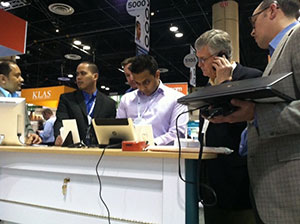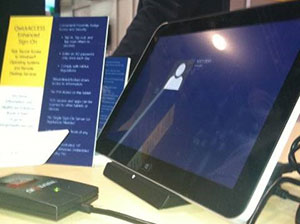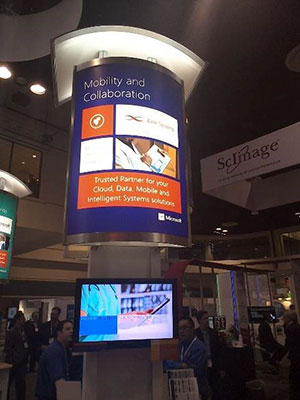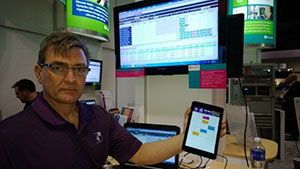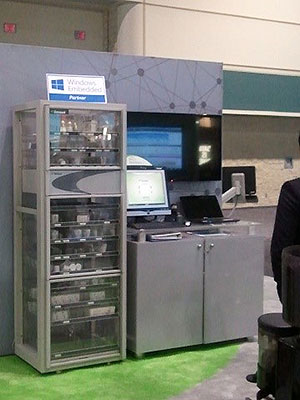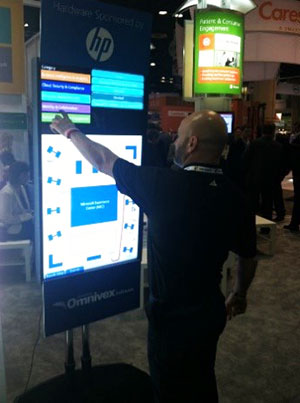Intelligent systems in health: Addressing three key industry trends
Posted By Kristin Flandreau
Americas Group Business Lead
The Windows Embedded team in Microsoft’s HIMSS booth.
The Healthcare Information and Management Systems Society (HIMSS) 2014 Annual Conference & Exhibition wrapped up last month in Orlando, Fla. More than 37,000 health professionals and 1,200 exhibitors gathered for a week of learning as Microsoft showcased the many ways its newest technologies are pushing the cutting edge of the health industry — from helping to address the rising costs of care to enabling greater efficiency and better patient care. The Windows Embedded team and its healthcare partners successfully demonstrated how intelligent systems in health are addressing three key industry trends:
- Mobility in health
- Electronic health record (EHR) interoperability
- Patient engagement
Trend No. 1: Mobility in healthcare
Partners embraced Windows Embedded 8.1 Industry Pro tablets, with their enhanced lockdown features and plug-and-play peripheral support, as complementary devices to Windows 8 tablets. Intelligent systems partners including Greenway Medical, iLink Systems, HealthCast Solutions and IFS America showed industry tablets that can help improve EHR integration, increase clinician productivity and enhance patient care.
Greenway PRIMEMobile on a Dell Venue 8 with Windows Embedded 8.1 Industry Pro.
Greenway Medical demonstrated its PrimeMOBILE application running on a Windows Embedded 8.1 Industry Pro tablet. The PrimeMOBILE application allows clinicians to care for patients from virtually anywhere. It works with Greenway Medical’s PrimeSUITE EHR, allowing healthcare providers to check schedules, access patient data, capture charges, document data and more.
HealthCast QwickACCESS on an HP ElitePad.
HealthCast Solutions demonstrated the flip side of mobility in healthcare with a single sign-on solution, QwickACCESS, which gives clinicians quick, secure access to EHR data as they move from device to device within a healthcare facility over the course of their day. A doctor or nurse simply “taps in” to access the EHR application using a proximity badge or biometric device. In this case, mobility means that doctors and nurses can quickly move from device to device and seamlessly pick up work where they left off at a previous device. HealthCast showed its enhanced sign-on solution on an HP ElitePad running Windows Embedded 8.1 Industry Pro, also illustrating the traditional concept of mobility. A doctor or nurse “taps in” to the EHR application accessed from the tablet, just like they would from a thin client, and carries the tablet as he or she works, providing flexible choices in mobility but the same user interface.
iLink Systems at HIMSS.
Partner iLink Systems demonstrated an intranet framework using Office 365 and a Checklist/Survey/Forms framework for health services. The intranet framework helps healthcare organizations quickly set up an intranet using SharePoint 2013. The framework helps the organization easily create checklists, forms and surveys and deploy them to their on-premises or in-cloud installation of SharePoint 2013. iLink Systems’ frameworks can be accessed through any device with any form factor; it was demonstrated using a Microsoft Surface Pro 2 and a Dell Venue 8 Windows Embedded 8.1 Industry Pro tablet.
IFS' home healthcare scheduling application.
IFS demonstrated its home healthcare scheduling application running on a Windows Embedded 8.1 Industry tablet. The application enables home healthcare workers to be routed to their visits, to receive instructions and to log information as they travel from home to home. The application can also be used in asset management scenarios such as maintaining MRI scanners. The Windows Embedded 8.1 Industry tablet is ideal because of its lockdown features, which allow healthcare workers to access only designated applications, making the tablet a fixed-function device.
Trend No. 2: Electronic health record (EHR) interoperability with medical devices and systems
The interoperability between Omnicell’s automated dispensing cabinets — the G4 platform shown here — and electronic health records results in new efficiencies in medication administration. This interoperability enables nurses to simultaneously issue medications and view a patient record in a single view, pulling data in from multiple sources, saving nursing time and leading to increased patient safety.
Omnicell recently installed this solution at Billings Clinic in Billings, Mont., and reports that solutions like this one have become “… increasingly vital to improving care coordination.”
Trend No. 3: Patient engagement
Digital sign at Microsoft booth.
Omnivex and HP provided a wayfinding sign for the Microsoft booth. The sign illustrated the trend of using digital signage in clinics and hospitals to drive patient engagement by delivering the right message to the right person at the right place and time. Doctors can deliver customized messages to patients who are waiting for an appointment and healthcare facilities can deliver custom content to patients and families. Digital signage can also be used to entertain waiting patients and their families.
Echoing the findings of IDC on improving healthcare delivery with intelligent systems, the pressures of raising the quality of patient care while reducing costs are creating a requirement for a new generation of intelligent healthcare IT systems. At the HIMSS event, our partners did an impressive job of demonstrating how they are meeting these new requirements and supporting key trends. By offering innovative solutions for mobility, interoperability and improved patient engagement, our partners are leading the way to improve patient care, reduced costs and improved ROI for healthcare providers. Read more on Microsoft’s intelligent systems in healthcare.
